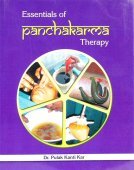Mokshana, Mokṣaṇa: 14 definitions
Introduction:
Mokshana means something in Hinduism, Sanskrit, Marathi. If you want to know the exact meaning, history, etymology or English translation of this term then check out the descriptions on this page. Add your comment or reference to a book if you want to contribute to this summary article.
The Sanskrit term Mokṣaṇa can be transliterated into English as Moksana or Mokshana, using the IAST transliteration scheme (?).
In Hinduism
Natyashastra (theatrics and dramaturgy)
Source: Wisdom Library: Nāṭya-śāstraMokṣaṇa (मोक्षण, “shooting”) refers to one of the four acts related to the bow (dhanus). It is a Sanskrit technical term defined in the Nāṭyaśāstra chapter 11. Accordingly, “shooting (mokṣaṇa) is the release [of the arrow]”.

Natyashastra (नाट्यशास्त्र, nāṭyaśāstra) refers to both the ancient Indian tradition (shastra) of performing arts, (natya—theatrics, drama, dance, music), as well as the name of a Sanskrit work dealing with these subjects. It also teaches the rules for composing Dramatic plays (nataka), construction and performance of Theater, and Poetic works (kavya).
Ayurveda (science of life)
Toxicology (Study and Treatment of poison)
Source: Shodhganga: Kasyapa Samhita—Text on Visha ChikitsaMokṣaṇa (मोक्षण) refers to “that which discharges poison”, according to the Kāśyapa Saṃhitā: an ancient Sanskrit text from the Pāñcarātra tradition dealing with both Tantra and Viṣacikitsā—an important topic from Āyurveda which deals with the study of Toxicology (Viṣavidyā or Sarpavidyā).—Kāśyapa has recommended a slew of generic formulae that successfully neutralise rat poison.—According to Kāśyapasaṃhitā (verse 11.53): “A measure or khāri of the root of Carvā destroys (mokṣaṇa) rat poison. The oil prepared from the bark of Taṭāka and the root of sira also make a medicine”.

Āyurveda (आयुर्वेद, ayurveda) is a branch of Indian science dealing with medicine, herbalism, taxology, anatomy, surgery, alchemy and related topics. Traditional practice of Āyurveda in ancient India dates back to at least the first millenium BC. Literature is commonly written in Sanskrit using various poetic metres.
Languages of India and abroad
Marathi-English dictionary
Source: DDSA: The Molesworth Marathi and English Dictionarymōkṣaṇa (मोक्षण).—n S Loosing, freeing, setting at liberty.
Source: DDSA: The Aryabhusan school dictionary, Marathi-Englishmōkṣaṇa (मोक्षण).—n Loosing, setting at liberty.
Marathi is an Indo-European language having over 70 million native speakers people in (predominantly) Maharashtra India. Marathi, like many other Indo-Aryan languages, evolved from early forms of Prakrit, which itself is a subset of Sanskrit, one of the most ancient languages of the world.
Sanskrit dictionary
Source: DDSA: The practical Sanskrit-English dictionaryMokṣaṇa (मोक्षण).—[mokṣ-lyuṭ]
1) Releasing, liberating, emancipating, setting at liberty; यावनवध्यस्य वधे तावान् वध्यस्य मोक्षणे (yāvanavadhyasya vadhe tāvān vadhyasya mokṣaṇe) Manusmṛti 9.249.
2) Rescuing, deliverance.
3) Loosening, untying.
4) Giving up, abandoning, resigning.
5) Shedding.
6) Squandering.
7) Discharging, casting; शस्त्र (śastra) &c.
-ṇī The magic art of releasing any one.
Derivable forms: mokṣaṇam (मोक्षणम्).
Source: Cologne Digital Sanskrit Dictionaries: Shabda-Sagara Sanskrit-English DictionaryMokṣaṇa (मोक्षण).—n.
(-ṇaṃ) 1. Letting go or free, liberating. 2. Squandering. 3. Giving up. 4. Causing to flow. E. mokṣ to let go, lyuṭ aff.
Source: Cologne Digital Sanskrit Dictionaries: Benfey Sanskrit-English DictionaryMokṣaṇa (मोक्षण).—i. e. moksh + ana, n. 1. Letting go (shedding of blood), [Mālavikāgnimitra, (ed. Tullberg.)] [distich] 62. 2. Liberation, [Pañcatantra] 143, 6. 3. Squandering.
Source: Cologne Digital Sanskrit Dictionaries: Cappeller Sanskrit-English DictionaryMokṣaṇa (मोक्षण).—[adjective] freeing, delivering; [neuter] deliverance, acquittance, loosening, untying, letting go or flow, giving up.
Source: Cologne Digital Sanskrit Dictionaries: Monier-Williams Sanskrit-English Dictionary1) Mokṣaṇa (मोक्षण):—[from mokṣ] mfn. liberating, emancipating, [Catalogue(s)]
2) [v.s. ...] n. liberation, releasing, rescuing, [Mahābhārata; Mṛcchakaṭikā]
3) [v.s. ...] setting at liberty (a criminal), [Manu-smṛti ix, 249]
4) [v.s. ...] loosing, untying, [Pañcatantra]
5) [v.s. ...] shedding, causing to flow, [Mālavikāgnimitra; Suśruta] (cf. rakta-m)
6) [v.s. ...] giving up, abandoning, deserting, [Pañcatantra; Hitopadeśa] ([varia lectio])
7) [v.s. ...] squandering, [Horace H. Wilson]
Source: Cologne Digital Sanskrit Dictionaries: Yates Sanskrit-English DictionaryMokṣaṇa (मोक्षण):—(ṇaṃ) 1. n. Setting free, liberating; squandering.
Source: DDSA: Paia-sadda-mahannavo; a comprehensive Prakrit Hindi dictionary (S)Mokṣaṇa (मोक्षण) in the Sanskrit language is related to the Prakrit word: Mokkhaṇa.
[Sanskrit to German]
Sanskrit, also spelled संस्कृतम् (saṃskṛtam), is an ancient language of India commonly seen as the grandmother of the Indo-European language family (even English!). Closely allied with Prakrit and Pali, Sanskrit is more exhaustive in both grammar and terms and has the most extensive collection of literature in the world, greatly surpassing its sister-languages Greek and Latin.
Kannada-English dictionary
Source: Alar: Kannada-English corpusMōkṣaṇa (ಮೋಕ್ಷಣ):—
1) [noun] the act of releasing, freeing, liberating.
2) [noun] a discharging of an arrow from the bow; a shooting.
3) [noun] (dance.) a particular gesture of the hand.
Kannada is a Dravidian language (as opposed to the Indo-European language family) mainly spoken in the southwestern region of India.
See also (Relevant definitions)
Starts with: Mokshanarasimha.
Ends with: Amokshana, Asrigvimokshana, Asrijvimokshana, Baliputramokshana, Banamokshana, Gajendramokshana, Kshvelamokshana, Parimokshana, Parvatimokshana, Pramokshana, Pranamokshana, Pratimokshana, Ragadveshamohaparimokshana, Raktamokshana, Rinamokshana, Samsaramokshana, Shariravimokshana, Vanamokshana, Vimokshana, Vipramokshana.
Full-text (+4): Raktamokshana, Pranamokshana, Vimokshana, Vanamokshana, Banamokshana, Samsaramokshana, Gajendramokshana, Raktamoksha, Amokshana, Pratimokshana, Mokkhana, Pramokshana, Parvatimokshana, Putanamokshanaprastava, Mokshani, Baliputramokshana, Parimokshana, Gajendra, Panagadi, Mushikakshvela.
Relevant text
Search found 6 books and stories containing Mokshana, Mokṣaṇa, Moksana, Mōkṣaṇa; (plurals include: Mokshanas, Mokṣaṇas, Moksanas, Mōkṣaṇas). You can also click to the full overview containing English textual excerpts. Below are direct links for the most relevant articles:
Bhajana-Rahasya (by Srila Bhaktivinoda Thakura Mahasaya)
Text 23 < [Chapter 1 - Prathama-yāma-sādhana (Niśānta-bhajana–śraddhā)]
Atharvaveda and Charaka Samhita (by Laxmi Maji)
Viṣa (poison) according to Caraka < [Chapter 4 - Diseases and Remedial measures (described in Caraka-saṃhitā)]
Gulma (abdominal swelling) according to Caraka < [Chapter 4 - Diseases and Remedial measures (described in Caraka-saṃhitā)]
Natyashastra (English) (by Bharata-muni)
Shishupala-vadha (Study) (by Shila Chakraborty)
Hīnasandhi (a) < [Chapter 3 - Six fold policies of a king (Ṣāḍguṇya)]
The Skanda Purana (by G. V. Tagare)
Chapter 28 - The Greatness of Gaṅgā (continued) < [Section 1 - Pūrvārdha]
Serpent Power (Kundalini-shakti), Introduction (by Arthur Avalon)
Related products
